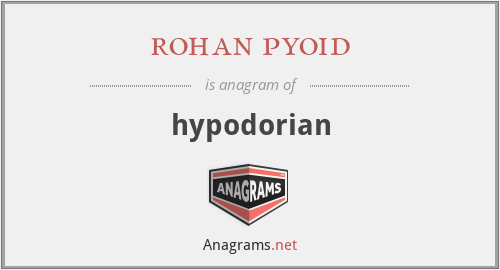What anagrams are available for hypodorian?
This page is about an anagram for the word rohan pyoid that can be used in word games, puzzles, trivia and other crossword based board games.
rohan pyoid
Translation
Find a translation for rohan pyoid in other languages:
Select another language:
- - Select -
- 简体中文 (Chinese - Simplified)
- 繁體中文 (Chinese - Traditional)
- Español (Spanish)
- Esperanto (Esperanto)
- 日本語 (Japanese)
- Português (Portuguese)
- Deutsch (German)
- العربية (Arabic)
- Français (French)
- Русский (Russian)
- ಕನ್ನಡ (Kannada)
- 한국어 (Korean)
- עברית (Hebrew)
- Gaeilge (Irish)
- Українська (Ukrainian)
- اردو (Urdu)
- Magyar (Hungarian)
- मानक हिन्दी (Hindi)
- Indonesia (Indonesian)
- Italiano (Italian)
- தமிழ் (Tamil)
- Türkçe (Turkish)
- తెలుగు (Telugu)
- ภาษาไทย (Thai)
- Tiếng Việt (Vietnamese)
- Čeština (Czech)
- Polski (Polish)
- Bahasa Indonesia (Indonesian)
- Românește (Romanian)
- Nederlands (Dutch)
- Ελληνικά (Greek)
- Latinum (Latin)
- Svenska (Swedish)
- Dansk (Danish)
- Suomi (Finnish)
- فارسی (Persian)
- ייִדיש (Yiddish)
- հայերեն (Armenian)
- Norsk (Norwegian)
- English (English)
Definition
What does hypodorian mean?
- hypodorian
- The Hypodorian mode, a musical term literally meaning 'below Dorian', derives its name from a tonos or octave species of ancient Greece which, in its diatonic genus, is built from a tetrachord consisting (in rising direction) of a semitone followed by two whole tones. The rising scale for the octave is a single tone followed by two conjoint tetrachords of this type. This is roughly the same as playing all the white notes of a piano from A to A: A | B C D E | (E) F G A. Although this scale in medieval theory was employed in Dorian and Hypodorian, from the mid-sixteenth century and in modern music theory they came to be known as the Aeolian and Hypoaeolian modes.The term Hypodorian came to be used to describe the second mode of Western church music. This mode is the plagal counterpart of the authentic first mode, which was also called Dorian. The ecclesiastical Hypodorian mode was defined in two ways: (1) as the diatonic octave species from A to A, divided at the mode final D and composed of a lower tetrachord of tone–semitone–tone, ending on D, plus a pentachord tone–semitone–tone–tone continuing from D, and (2) as a mode whose final was D and whose ambitus was G–B♭ (that is, with B♮ below the final and B♭ above it). In addition, the note F, corresponding to the reciting note or tenor of the second psalm tone, was regarded as an important secondary center.
Embed
Citation
Use the citation below to add this anagram to your bibliography:
Style:MLAChicagoAPA
"rohan pyoid." Anagrams.net. STANDS4 LLC, 2024. Web. 15 May 2024. <https://www.anagrams.net/term/22625638>.



Discuss this hypodorian anagram with the community:
Report Comment
We're doing our best to make sure our content is useful, accurate and safe.
If by any chance you spot an inappropriate comment while navigating through our website please use this form to let us know, and we'll take care of it shortly.
Attachment
You need to be logged in to favorite.
Log In